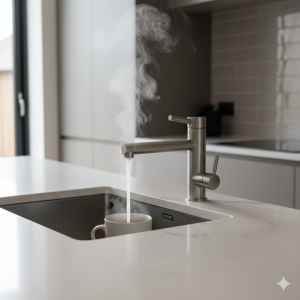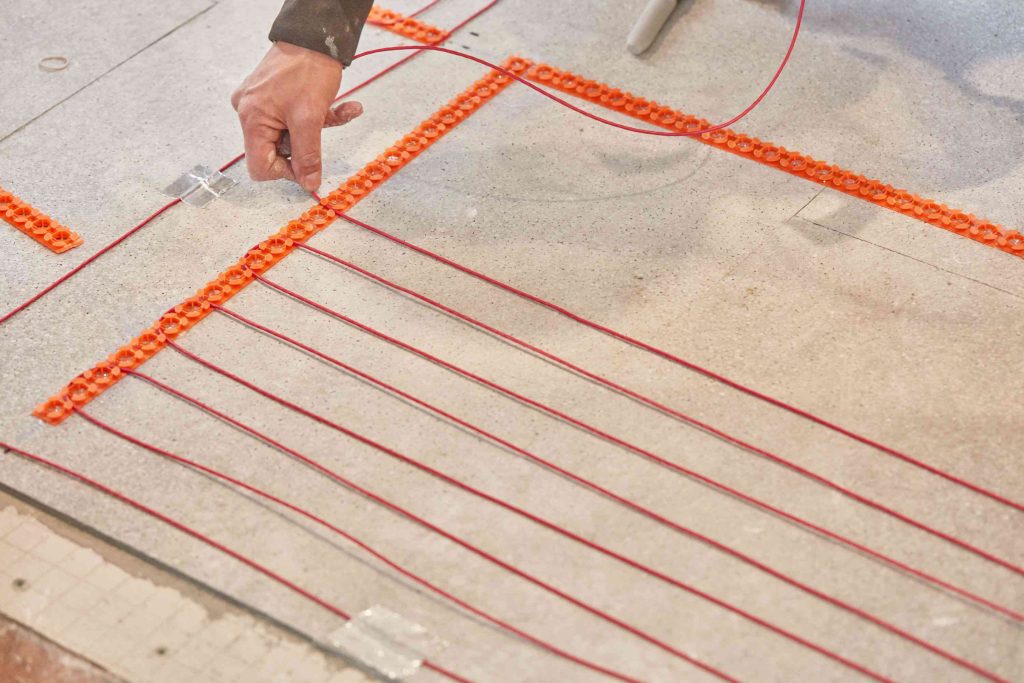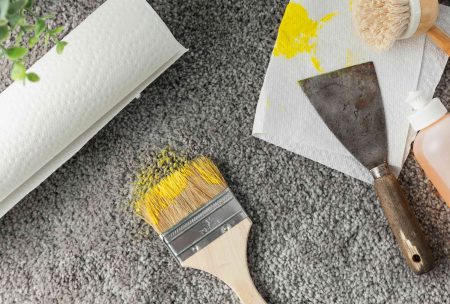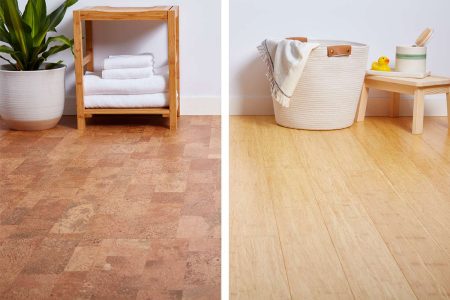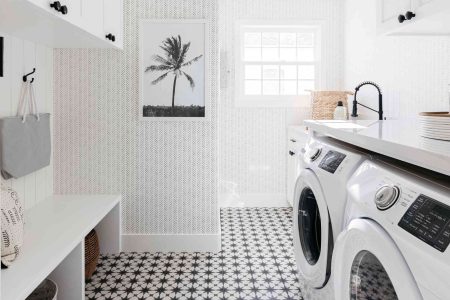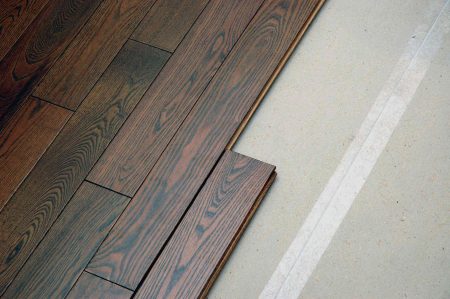Radiant floor heating systems offer gradual, room-filling convection heat that is silent and relatively energy efficient. Bathrooms, bedrooms, and even kitchens in cool climates that have radiant heating feel comfortable and easy on bare feet—all the time.
Radiant floor heating can be installed under a surprisingly large number of floor coverings. Yet due to the amount of heat generated by these systems’ electric wires or hydronic tubes, not all floor coverings can be installed over them.
Best Floor Covering to Use With Radiant Heating
While a number of floor coverings are suitable for radiant heating, what would be the single best flooring to use?
Ceramic tile is the most effective type of floor covering to use with radiant floor heating.
Ceramic tile is an excellent conductor of heat, plus it retains heat between system cycles. On top of that, ceramic tile is inexpensive, available, easy to install, and waterproof.
On the second tier are all other floor coverings that are insulators more than they are conductors: laminate flooring, luxury vinyl flooring, vinyl tile, sheet vinyl, linoleum, wood, and carpeting. The radiant floor heating system is required to work harder and longer (that is, shorter off-cycles) to transmit the heat through insulating materials.
Ideal Flooring Properties for Radiant Heating
Properties that make a floor covering good or bad for radiant heating systems tend to center around the thickness of the flooring, the flooring’s thermal conductive nature, its tendency to expand and contract, and whether it is prone to water and heat damage.
Thicker floor coverings like solid hardwood and engineered wood are poor thermal bridges. Mineral-based floor coverings, chiefly tile and stone, are excellent thermal conductors. Solid hardwood can easily be damaged by heat and moisture.
Porcelain, ceramic, and natural stone are the best flooring materials for radiant heating as they encompass all four factors. On top of it, tile tends to feel colder than other types of flooring, so the need for radiant heating underneath is greatest.
The least desirable flooring for radiant heating—carpeting—fails on several points, but it can still be used.
Porcelain or Ceramic Tile
Porcelain and ceramic tile are ideal for use with radiant floor heating systems. Not only is tile thin but its mineral-based nature means that it conducts heat well. Additionally, since tile contains no organic products, it will not rot or degrade if a hydronic system leaks water.
Tile heats up rapidly as soon as the system turns on and it also retains heat for a short while after the system shuts off.
Natural Stone Flooring
Similar to ceramic and porcelain tile, any kind of natural stone or aggregate stone is a natural fit for radiant heating systems. Not only is stone safe to use over radiant heating, but it also retains heat for a longer period than tile after the system shuts-off.
Natural stone flooring is slightly thicker than ceramic and porcelain tile, so it heats up a bit slower than tile. But it does retain heat for a long time, it never expands or contracts, and it cannot degrade.
Laminate Flooring
Laminate flooring’s thinness is an asset when installing radiant heating, allowing the heat to penetrate and dissipate. Precautions must be taken to protect the flooring, though.
In hydronic systems, should moisture escape, the laminate would be permanently damaged. The temperature of the system must be kept below the maximum point that is recommended by the laminate flooring manufacturer. Many laminate flooring manufacturers recommend that the temperature should never exceed 85 degrees.
One benefit of laminate flooring on its own is that it feels warm underfoot. The wood content in the laminate base, combined with the foam underlayment, makes for a generally comfortable feeling. So, you may want to use radiant heating under laminate flooring only in very cold rooms.
Sheet or Tile Vinyl Flooring
Radiant heating can be installed under resilient floorings such as sheet vinyl, tile vinyl, and luxury vinyl plank. Check the manufacturer’s installation instructions for maximum temperatures. Generally, begin with 65 degrees during the first 24 hours of use, increasing to no more than 85 degrees.
Engineered Wood Flooring
Between solid hardwood and engineered wood flooring, the latter is recommended as a better candidate for radiant heating systems.
Engineered wood flooring employs high-quality plywood as a base for its top layer of hardwood veneer. This type of plywood is dimensionally stable and does not quickly respond to temperature spikes or drops.
However, wood is a poor thermal conductor. This means that heat from the system will not transmit as quickly or as thoroughly as with thinner floors that are more thermally conductive.
Carpeting
Due to the excellent insulating properties of carpeting, radiant heating systems will experience efficiency reduction and thus may require that the thermostat is turned up higher than it would be with hard flooring.
Carpeting can be used with radiant heating but it should be a thin type of carpeting that has dense padding.
Solid Hardwood Flooring
Engineered wood flooring works better for radiant heating than under solid hardwood. But if you do wish to put radiant heating under solid hardwood, use quarter-sawn wood flooring instead of plain-sawn wood flooring. The heating element should be embedded within a sleeper system subfloor, under a traditional subfloor, or embedded within concrete.
Narrower floorboards tend to work better than wide-plank because the multiplicity of seams allows for more flexibility if the floor should expand and contract. Extremely dense hardwoods that rank 1,375 or more on the Janka hardness scale are a poor fit for radiant heating systems.
Floors That Should Not Have Radiant Heat Flooring
- Rubber flooring does not react well to high heat and may give off unpleasant odors.
- Radiant heating can dry and loosen the adhesive on glued-down carpeting. In fact, any type of flooring that employs adhesive as its joining system is a poorer choice for radiant heating systems than flooring that uses tongue-and-groove or fold-and-lock seaming.
- Since concrete flooring is homogeneous, concrete alone is a poor choice for radiant heating. Radiant systems require layered flooring so that the tubing can be hidden under the top layer. However, radiant heat systems can be embedded in concrete floor slabs, as long as a subsequent top floor covering such as tile is added.
Read the full article here
